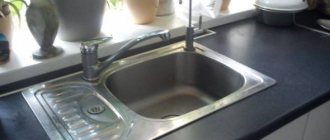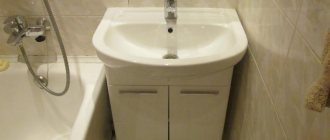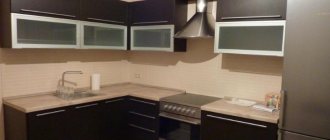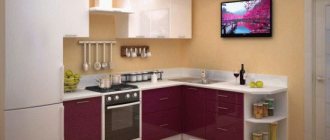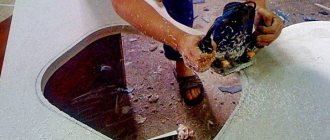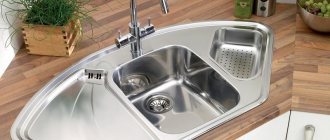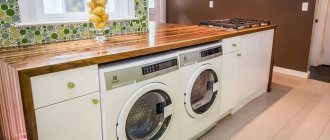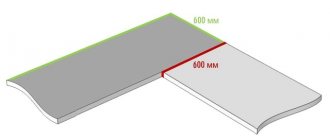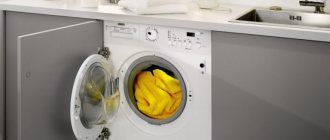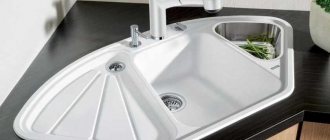Design Features
High-quality sink cabinets are a great necessity in every home. The purchase of these products must be thoughtful and balanced, because for the kitchen you need to select furniture that is optimal in size. It is also important to purchase products based on their aesthetic and decorative features.
This workplace should be very comfortable and preferably multifunctional, since the corner is a fairly large space.
When choosing, you need to consider what functions this bedside table performs:
- The practical side. Rationalization of the square footage in the room - the object takes up a minimum of free space, in addition, it houses other household appliances: a cabinet, a sink, communications, etc.
- A corner cabinet connects the kitchen unit along the walls.
- Expressiveness and aesthetics. If all the elements of the room’s style, including the sink-bedside table, are correctly selected, the kitchen will look quite representative.
- Aspect of comfortable use. If you plan the purchase and installation of the cabinet correctly, it will always be quite convenient for the housewife to use the cabinet while cooking.
A corner kitchen set is a necessary necessity: the size of the kitchen is not large enough to place everything you need along one wall.
Important.
If a person wishes, he can construct the necessary sample himself, which will meet his purely personal needs.
Types of construction
There are three types of corner cabinets based on the type of design:
- straight attached;
- L-shaped;
- trapezoidal.
Each has its own characteristics, which we will now reveal.
Straight cabinet
An ordinary floor cabinet, which has one blank door - a false panel. This option is the most budget-friendly, and therefore the most common. But using it is not very convenient - there is a lot of free space, but it is difficult to reach it.
The standard dimensions of such a cabinet for a sink are 100 by 60 cm along the countertop. At the same time, the module itself will be slightly smaller - 95 by 55 cm. This is due to the fact that the tabletop should hang slightly in front, on the side and even sometimes in the back.
With this situation, the size of the facade is 71.6 by 39.6 cm. We must not forget about the internal component - on the inner side of the cabinet they make a cut under the sink, or rather, its communications.
In this case, the dimensions are individual, but most often this hole is about 25 by 15 cm. If the pipes require a larger hole size, then it is better to make the side side not solid, but assembled from planks.
L-shaped cabinet (acute angle)
Here the cabinet is equipped with a special transforming door, thanks to which it is very convenient to use the interior space. Moreover, in terms of measurement, this is the most flexible option.
In this case, one or two back sides of the cabinet are left hollow - this depends on the number of connections and wiring. The dimensions of a standard cabinet are 92 by 92 cm. In addition, two doors with sides of 71.6 by 39.6 cm are required.
Such modules can be easily customized by simply trimming one of the sides. It is worth remembering that a wide door is always hung on the side, and a light door is always hung on it (the first door). If you do otherwise, the facade will sag over time.
Trapezoidal cabinet (with beveled corner)
The largest and most cumbersome version of a corner kitchen table for a sink. It is advisable not to install it in small rooms, as it takes up too much usable space. For this reason, they are appropriate only in spacious rooms with a classic design. The options listed above look better in modern kitchens.
If the trapezoid cabinet seems too rough and large, then you can choose a concave design for the door and table top, but this will not solve the problem of bulkiness. It is in this option that the problem of a small door and a huge free space inside is very acute. The dimensions of the module are 90 by 90 cm, with the door being 71.6 by 47 cm.
Another disadvantage of such a cabinet is that an ordinary 60 cm countertop does not cover the entire surface, so it has to be joined, and this threatens water from the sink getting into the seams and swelling of the material. Such a joint is made either at the sink level or with the help of a small supporting superstructure.
Of course, if you use another material, for example, artificial stone or plastic, then this problem can be avoided. But the cost will be completely different. Manufacturers are trying to solve this problem by producing special pentagonal countertops, but so far their selection is very limited.
Varieties
If a product is in demand, it will always have many variations. Let's look at the most popular products:
- Classic L-shape. It is suitable for small spaces, so it fits into the area of most apartments of the post-Soviet period. Schematically, everything is extremely simple - the bedside table with the sink is connected by a kitchen unit, which is located in the shape of the letter “L”.
- Furniture in the shape of the letter "P". Schematically, it may be similar to the L-arrangement. It’s just that now the set is longer, the furniture runs in straight lines along the entire perimeter of the kitchen, near the walls.
- Trapezoid bedside table. Quite a functional option, which entails a higher cost compared to previous products.
- Sink with beveled corners. Interesting design idea. Looks great and modern in a modern kitchen.
Note. Sink cabinets can also be classified according to the material they are made of. For example, from wood, possibly from rare species, or a cheaper and more practical option - from chipboards or wood-fiber material.
How to choose the size of a corner sink?
Although we are only talking about the sizes of corner sinks now, this is still a very important point. If you make a mistake at this stage, you can end up with non-functional space, incorrect installation, or simply lose money. Due to the complexity of installation, the dimensions of corner sinks must be approached very carefully.
First, let's define what sink size means. Conventionally, this characteristic can be divided into two more: area - that is, width and length; depth.
The easiest way to determine the depth is - it should be about 16–20 centimeters. If this value is less, then splashes will fly in all directions and spoil the mood of the hostess.
If you follow the rule “the more, the better,” you can get back problems, since you will often have to bend over too much. This is especially true for low countertops below 85 centimeters.
The photo shows an example of a corner sink made of artificial stone with dimensions and available colors.
Now let’s decide on the factors that influence what size corner sink to choose:
- Dimensions of the kitchen unit - it is obvious that the cabinet can and should be larger than the built-in sink, but this does not work in the opposite direction.
- The size of the dishes - if it is customary in the family to eat “a little, but often,” for example, from saucers, then there is no point in a large sink. But if the family is large with multi-liter frying pans and pots, then it’s worth taking a closer look at the volumetric options;
- The presence of wings at the sink and their location . If the owner is right-handed, then the wing should be on the right, and vice versa;
- The sink should not be adjacent to the wall or the base of the countertop, so it is better to make a gap of 5 centimeters;
- Type of shell . The discussion above was about mortise and under-table models. With overheads, everything is simpler - like the cabinet, like the sink.
Each corner sink shape has standard sizes that are most commonly found.
| Square | 50x50 cm, 60x60 cm |
| Rectangular | 55x50 cm, 50x80 cm, 50x100 cm, 50x125 cm |
| Round | Diameter from 45 to 51 cm |
Tips for choosing
Interior design is a delicate matter. Every housewife dreams of arranging her living space, while choosing the right furniture to match the interior of the room itself. As for the kitchen cabinet, it should also be functional, in addition to aesthetic aspects. How to choose the right product?
The corner cabinet under the sink plays a connecting function between the cabinets on two walls.
To do this, you must follow the following recommendations:
- The design of the room, as a rule, will tell you which sink you should purchase. Of course, choose options that will fit into the style of a separate room or the entire apartment.
- Another important factor in the choice is the material from which the products are made. Always give your vote to eco-friendly products.
- You should pay attention to reliability and practicality, reviews for specific models. Find out how durable a pressure washer is.
- To what extent does this design suit the owners? The psychological factor plays a huge role. The most trendy products will not be desirable if the consumer had prejudices towards them from the very beginning.
A corner kitchen cabinet is much larger than its straight counterparts and, accordingly, will accommodate a larger number of kitchen utensils.
Additional Information. The sink cabinet should concentrate two main features: beauty and functionality.
Form
Once the material and method of attaching the corner sink have been determined, it’s time to choose the shape of the bowl. For a long time in our country, the most common option for placement in a corner was considered to be a round sink, so we will begin our review of various models with it.
- Round . The main advantage of this bowl shape is that it can accommodate a large number of dishes in a relatively small area. It must be admitted that in square and rectangular bowls the corners are not used, and dirt accumulates in them - a round sink does not have this drawback. In addition to excellent functionality, one can highlight the visual appeal of this form. The interior will look original.
- Square . This is a versatile and also roomy option. The advantage is that it can even fit on a non-standard tabletop, for example, a narrow one. In such cases, additional functional elements may appear - wings, boards and other accessories for washing. It will look great in a small kitchen.
- Rectangular . Similar to square ones, but more bulky. Such specimens are chosen to increase the functionality of the sink.
But triangular and oval sink bowls are very rare, but these geometric shapes are often taken as the basis for the entire sink.
How to make a corner cabinet yourself
The kitchen is probably the favorite place to spend time for both adults and children. It’s so nice to have dinner with your family, gossip or just sit with a cup of coffee. Therefore, everything on it should be perfect (in the opinion of specific owners). If you cannot find a suitable design, it can be made. This is also possible with a sink cabinet.
This place is almost always used for installing a sink, which means that a siphon, pipes, and technical communications will be hidden in the cabinet.
First of all, you need to decide:
- what type of product needs to be invented, its dimensions;
- view and familiarize yourself with information on this issue, be sure to study photo and video materials;
- calculate estimates for materials, tools, etc.
Important! In most cases, making it yourself is much cheaper than buying it in a store.
If the preparatory stage is completed, you can begin the actual work. It’s better to start with the classic version, simpler, but also the most popular - L-shaped.
In stores you can most often buy a kitchen set with an L-shaped corner sink or with a trapezoidal cabinet under the sink.
Drawing and dimensions
The initial stage of work is to decide on the size of the corner cabinet for the kitchen sink. To do this, you first need to take appropriate measurements of the room and draw a diagram of the project.
The back part for a trapezoidal bedside table is formed according to the same principle as for a rectangular one, otherwise the schematic drawing looks like this.
In the drawing, it is necessary to take into account communications at the site, whether other elements of furniture or equipment will be located near the sink. As a rule, the drawing can first be made on a simple squared piece of paper from a notebook. Modern technologies make it possible to subsequently create a three-dimensional project on a computer, etc. The scheme should include:
- View of the structure from all angles. From the side, from above.
- It is imperative to detail the drawing, down to the smallest samples. If this is a classic, then highlight the dimensions of the right and left cabinets (which are located near the sink), indicate the horizontal connection of these objects (front side) and all subsequent connecting strips.
- Clearly design parts of the frame, walls, back and floor coverings, facade, etc.
- It is necessary to thoroughly consider the placement of shelves and doors.
The drawing with one blank wall is relevant when supplying communications from the side.
The entire kitchen layout must fit into the overall interior of the kitchen unit.
Selection of tools and materials
Let's dwell on the materials from which it is possible to make a good bedside table. First, pay attention to the old furniture; some parts can be used to build a good sink. If you start work from scratch, you will need chipboard or MDF, as well as plywood. The entire product can be made exclusively from wood; sometimes folk craftsmen design excellent wooden objects, and even in a single copy.
A popular material for inexpensive furniture. The service life will largely depend on the finishing method.
Of the tools that are needed for the project, most are available from good owners, and if not, then you will have to purchase it, which will be a good investment for the future - the ability to produce similar crafts at any time. The necessary accessories and tools are as follows:
- roulette;
- pencil;
- hacksaw;
- screw tie;
- screwdrivers are different;
- priming;
- protective devices;
- cutter;
- drill;
- screwdriver;
- level;
- plane;
- jigsaw;
- nails, screws and self-tapping screws;
- hinges, handles, etc.
A good craftsman knows how to replace a tool he doesn’t have, or how to do without it.
Assembling the cabinet
Before starting the main work, you need to prepare the walls that will be behind the sink. They should be even. If the owners wish, they are covered with wallpaper or treated with appropriate materials. Start of assembly:
- divide all materials according to the drawing;
- varnish the surface of the samples;
- we fasten the fittings, check the façade parts (how well they correspond to the design);
- we assemble the main countertop, mark where the sink and cabinets will be located, and make the corresponding holes;
- we install upper and lower cabinets;
- We install the tabletop canvas.
All that remains is to screw the countertop, cut in the sink, put the structure in place and connect it to the sides of the set.
This is only a complex process at first glance, but if you plan your actions, a person with minimal knowledge of carpentry can build good furniture.
A large pentagonal-shaped cabinet, the front part of which has a beveled edge that overlaps the rectangular junction of the side modules.
Final stage
The final touch is the assembly of the facade parts, which must be done in advance and tried on during the installation of the main part. The doors are attached to pre-installed hinges. If necessary, handles are fixed (if they were not installed immediately).
Such solutions are characterized by greater capacity and provide convenient access to the internal contents.
Façade details are the part of the structure that will be most exposed. It will also be used quite often by all family members. Therefore, you need to select high-quality materials.
Either a mortise or overhead sink with one or two sinks and additional space for drying dishes can be installed on top of the base.
Note. It is necessary to do everything according to the previously developed scheme, and there will be no problems in the work. If a craftsman likes his craft, he can continue, the sink will become the starting point in the manufacture of the entire kitchen set.
Drawings of corner cabinets under the sink
If the shape of the underframe is expected to be rectangular, the project is drawn up according to one of two drawings. Their main difference is in the design of the rear part. The drawing with one blank wall is relevant when supplying communications from the side.
Classic cabinet under the sink in the corner
A cut of approximately 150x250 mm is made in the side of the base, depending on the dimensions of the supplied pipes. With a greater depth of communications, it is better not to make the sidewall solid, but to assemble it from narrow panels.
To connect the pipes you need a saw
If there will be connections for the washing machine and dishwasher below, as well as additional accessories such as counters, filtration systems, grinders and filter systems, it is better to leave the base without blank back walls.
Corner module without rear walls is convenient for supplying communications
Trapezoid-shaped washing table
The back part for a trapezoidal bedside table is formed according to the same principle as for a rectangular one, otherwise the schematic drawing looks like this:
Drawings of a corner lower kitchen module in the form of a trapezoid
Such designs in small kitchens look overly voluminous. Rounded corners and concave doors soften the impression a little.
The concave facade visually reduces the size of the cabinet
To equip trapezoidal bases with a solid tabletop, a wide laminated chipboard is required, which is more expensive than conventional analogs with a width of 60 cm. To use a standard tabletop, a two-level surface with a superstructure is made.
In the case of a standard slab, an extension in the corner can be used
Expert opinion
Svetlana Kolesnikova
Designer
Ready-made pentagonal slabs designed for trapezoidal sinks are available in the Leroy Merlin retail chain, but the choice of sizes and colors is somewhat poorer than among conventional countertops. IKEA also offers ready-made corner solutions, among which there are quite interesting ones designed for radius doors.
Where can I put it?
The location of the sink cabinet is a very important aspect in the interior design of the room. You can install this design:
- Near the gas stove. This is the most popular option. Since all the equipment is at hand, cooking happens much faster. But it’s unpleasant when detergent from the sink gets into your food. So, such proximity has its negative aspects.
- Corner or classic placement. This location is the most acceptable saving of square meters in a small space.
- Bedside table by the window. An interesting approach for those who like to see nature or city life from the window while cooking. Don't forget that washing windows will be twice as dirty.
- In the middle of the kitchen (also called an island). In most cases, such a cabinet is also a dining table. Unusual layout, somewhat reminiscent of a restaurant style. Remember that with this design, the water pipes will have to be adjusted to the sink.
Functions of a corner sink in the kitchen
Corner sink in the corner saves space well
Corner sinks are one of the ingenious inventions of mankind . Such sinks save square meters in the kitchen, make useful use of corners of the room that are usually not taken into account, and make the washing area quite spacious. If you really want, you can install a double kitchen sink in the corner, if the kitchen countertop allows it.
Work surfaces around the sink
There is much more space under the sink in corner sink cabinets than in regular rectangular and square ones. A built-in waste bin under the sink or various small items can be easily installed there.
The shape of the sink can be absolutely any. It is possible to order a sink made according to any design.
Advantages and disadvantages of kitchen sinks
Pros:
- Kitchen ergonomics.
- The cabinet space under the sink is larger than in conventional sink cabinets.
- Various sizes of kitchen sinks.
- Most corner sinks have a countertop that can be used for kitchen utensils, dirty dishes, and other items.
- The space behind the mixer is much larger than that of simple sinks. This will allow you to store several cleaning supplies there.
Minuses:
- A corner sink can only be installed in a corner . If there is a need to rearrange it, it will be quite problematic to find a new place for it.
- Many models that are presented on the plumbing market have a small bowl for washing.
- Models that are made in the shape of an arrow have a protruding corner in the middle. This design makes the washing process problematic because the mixer is located quite far from the edge. See also information about the best kitchen sink faucets.
Video review about mortise table sinks in interior design
Review of sinks from a sanitary ware manufacturer:
Methods for installing a corner kitchen sink
Most modern people with simple knowledge can install this object:
- we fasten the side parts with the bottom part;
- installation of a corner structure;
- we fasten the connecting components;
- installation of legs (if provided);
- We install doors and handles.
At the location of the washing unit, all communications necessary for its functioning are located.
Additional Information. When purchasing any furniture, a diagram is included, with which installation is quite simple. There are two installation methods: mortise and overhead.
Sink selection
Choosing a suitable sink should start with its installation option.
| Invoice | The simplest, but rarest option for a corner location. This sink takes up the entire space above the cabinet, so there is no need for a countertop. |
| Mortise | The most popular option. A hole is cut in the countertop into which the sink is inserted. It is held in place by the sides that lie on the tabletop, as well as with the help of special fasteners. A greater variety of such sinks allows you to choose the ideal model for any interior. |
| Integrated | There is no sink as such, since it is a recess in the countertop. Rare, but very effective option. |
| Podstolnaya | The most difficult option is to install the sink under the countertop. The installation is so complicated that a professional is needed, since everything needs to be calculated literally down to the millimeter. In addition, such washing is expensive. |
After choosing the type of sink installation, it is better to decide on its shape. There are three options:
- round - standard option with a diameter of 50 or 60 centimeters. Spacious, comfortable, no need to clean corners;
- straight (rectangular or square) - the standard size of corner sinks is 60 by 80 cm, but there are others. Volumetric, useful for a large family;
- non-standard shape - often used as corner sinks, since the non-standard shape allows optimal use of space.
It's worth thinking about equipping your kitchen sink. A classic is the sink, which is a single bowl.
If space allows, you can choose a multi-sectional product - with two or even three bowls. This is a very practical solution, because while dishes are being washed in one bowl, something can be defrosted or soaked in the other.
For such a purpose, wings are suitable - side corrugated surfaces made of the same material as the sink. Most often, they are also used for defrosting food or drying dishes.
Organization of space inside
How you can organize your interior space:
- Using a basket (mesh). All contents are clearly visible during operation.
- Lockers. You can separate some kitchen utensils and household chemicals on all shelves.
- Pull-out drawers. This is the most practical method for storing dishes.
- Pull-out (regular) trash can (or any container). Basically, consumers use the space under the sink this way.
- Mini pantry. We install small shelves, and we get a pantry for storing food that does not spoil for a long time.
A floor-mounted corner cabinet will help you make better use of your kitchen space, making it functional and cozy.
When choosing a suitable design, the main thing is that the kitchen furniture: be stable along with the sink, hide the main communications on the site, have a spacious cabinet and other characteristic features.
Corner cabinet for kitchen sink: types and sizes
Oddly enough, but the corner cabinet for the kitchen sink can be of two varieties - with a right internal corner and a beveled corner. Before deciding the immediate issue of manufacturing this part of the furniture set, you should understand the question, which of these options will be better?
- Right angle cabinet. As a rule, it has two doors that provide, albeit alternately, almost complete access to even the most remote corners of the corner cabinet. By and large, this is not one, but two bedside tables connected into one solid product, which has only one significant drawback - a small base area. In principle, if you do not use a huge trash can, then this is not a problem at all. Another disadvantage, which is also quite easily solved, is the inconvenient opening of two doors at once - this shortcoming is corrected by installing one folding door. These are still the same two doors, only connected to each other by another pair of special canopies. In all other respects (and even in manufacturing), such a cabinet looks very attractive, and most importantly, economical, since when cutting chipboard it does not create dead zones on the sheet, which usually go to waste.
Corner cabinet for kitchen sink photo - Cabinet with beveled corner. Its main advantage is the volume achieved due to the cut (or, more correctly, extended) angle. For this advantage you will have to pay with two disadvantages - inconvenient access to the far corners of the cabinet through a 450mm door and excessive consumption of material for its manufacture, which is expressed not only through the high consumption of chipboard, but also through the need to purchase a larger tabletop. In principle, you can put up with the last moments, but it’s somehow wrong to deal with inconvenient operation - first of all, the kitchen, or rather the furniture set, should be comfortable.
You will have to decide this issue yourself - the main thing is that you do not later regret the choice you made!
DIY installation
It doesn’t matter whether the cabinet is made by yourself or brought from the store, it is not difficult to assemble it yourself. Moreover, if this is a purchase from a store - in this case, the kit must contain detailed assembly instructions. If it is not there, then the principle of action is always the same:
- Assemble the sides.
- Attach the walls to the bottom.
- Assemble the fastening strips.
- Hang hinges, fasteners, hang doors.
- Install the countertop.
- Install the sink.
- Finish the seams.
- Connect to communications.
Installing a corner sink is no different from a regular one. The simplest option is the overhead model; it fits onto the cabinet with just a cap on the handle. The most difficult option is under-table - it is better to entrust it to a professional right away.
The integrated model does not require installation, as it is combined with the countertop. And you can install a built-in sink yourself. To do this you need:
- make markings on the countertop under the sink - usually for this purpose a special stencil is placed in the set for the sink;
- a hole is cut according to the markings;
- the ends are lubricated with sealant;
- the sink is inserted into the hole;
- fastenings are installed (if available);
- a siphon is installed and connected to the sewer;
- The junction of the sides of the sink and the countertop can also be coated with sealant.
As you can see, there is nothing complicated about this - even a beginner can handle it on his own.
